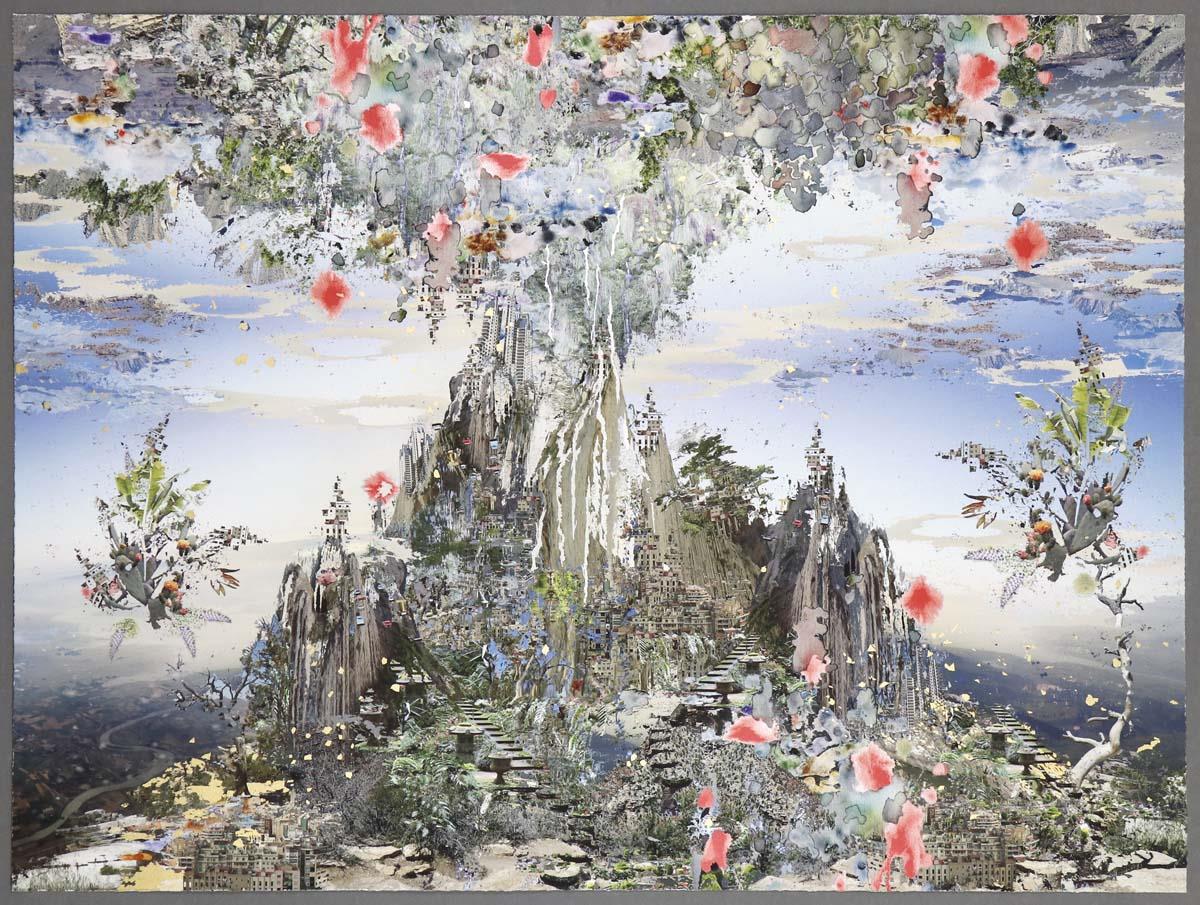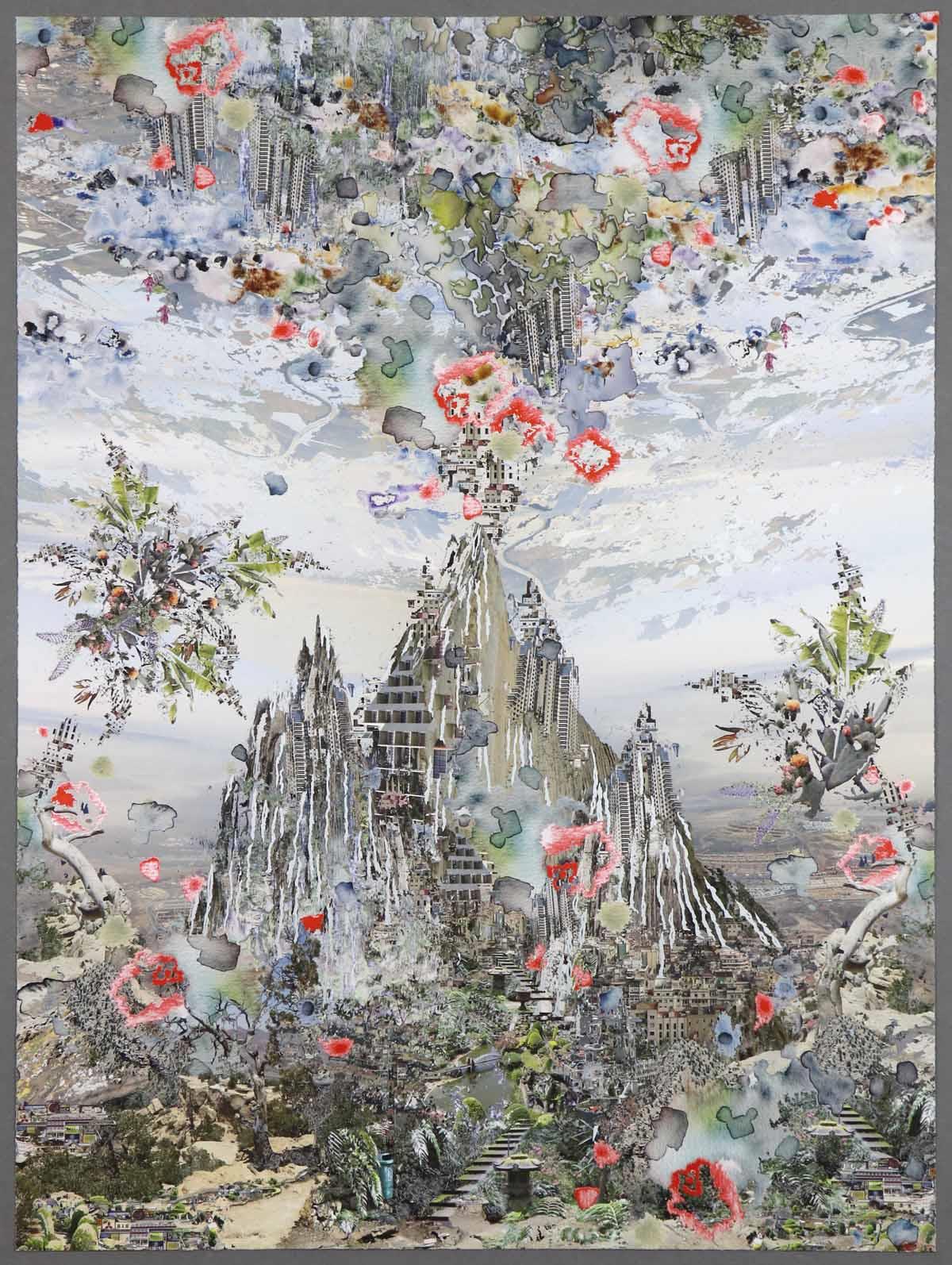British painter and photographer,
Jane Ward, has developed her practice by observing the changes in our everyday surroundings through the cycles of destruction and regeneration over time. From memories and personal photographs of cityscapes, villages, rural and industrial settings, the artist creates collages of wondrous worlds and intriguing natural sceneries. The familiarity of her work comes down to the simple fact that we have all been there.
The Other Side of the Mountains 1 and
The Other Side of the Mountains 2 represent the only two print editions by the artist where archival and silkscreen printing are combined, using hand-applied precious metal leaf to enhance highlights of the work.
Looking out the window, across the fields behind her childhood home, Ward noticed that things had changed since bustling days of coaling in the northern part of England in the sixties. Now in her early twenties, she was on a short visit back home while studying for her degree in Fine Art from Coventry University. The recession of the seventies and closure of the mines changed the landscape. From the window, she had expected to see how nature slowly was reclaiming the dusty, busy and industrial grounds. Instead, by the mid-eighties it was “claimed” by a golf course with its lush green architectural landscape - and some years later redeveloped into a housing complex. The memories of what once was, the transformation of our environment through the passage of time became the foundation of Ward’s work in the decades to come.
Nature and its elements always dominate meticulous and harmonious sceneries, but human interference is not far away. In
The Other Side of the Mountains 1 a mountain climbs high above the fields and rivers below. Houses are built into and climb up the mountain sides; peaks are extended by high-rising buildings; and terraced gardens which hints to one of the Seven Wonders of the Ancient World, the hanging gardens of Babylon. Taking a closer look and not all is what it seems. Little cars and heavy trucks are driving vertically up the mountain, though there are no roads - and palm trees formed of green leaves, orange fruits and little concrete structures are floating mid-air. In the top of the work, a hovering lavish garden unfolds, gently drizzling leaves made of 24-carat gold and what looks like red shimmery poppy petals - against a rising blue sky.

JANE WARD
The Other Side of the Mountains 1, 2015
Edition of 50
6 Artist Proof (APs)
100(w) x 75(h) cm
39.37(w) x 29.53(h) inches

JANE WARD
The Other Side of the Mountains 1, 2015
Edition of 50
6 Artist Proof (APs)
100(w) x 75(h) cm
39.37(w) x 29.53(h) inches
|
|
|
100(w) x 75(h) cm
39.37(w) x 29.53(h) inches
|
Archival print with screenprint and gold and palladium leaf on Somerset Satin Enhanced 330gsm paper
Signed and numbered on verso.
To see larger and more detailed image (2Mb file opens in new window), please click here
Edition of 50
|
|
Recognising the visual beauty and abundance in the artist’s work and her themes of mercurial passage of time and destruction, questions arise in the perception of Ward’s work. What is prospering and what is degenerating? To understand that the transformation of our surrounding world is inevitable is what is profoundly important in Ward’s artistic practice.
The artist’s landscapes are constructed by digitally placing together various fragments of images, either from photographs she has taken herself or sourced from elsewhere. Her use of imagery is fast, sometimes deliberately blurred as snapshots of the memory. Cropped, resized, rotated - again and again - these images are Ward’s inventive building blocks. Accompanied by hand-drawn elements, that are either added to the image digitally or painted directly onto the surface of the paper, the layered sceneries are build up fragment by fragment - as Ward constantly works over the pieces until she reaches that crucial point where more layers would diminish the work.
From the layers and collages of miniscule details, the composition of
The Other Side of the Mountains 2 is surfacing through foliage and vegetation - and rural settings and cityscapes. Office buildings, corporate logos and the arched bridge contribute an industrial influence which is often present in her work. With cropped imagery, often turned on its side or upside-down, it is easy for the viewer to lose a sense of direction and to divert into an abstract thinking. In
The Other Side of the Mountains 2, Ward cleverly uses natural stairways to gently guide the viewer up and down the steep hillsides, still making the mind wonder and at the same time provide a gravitational pull. Asian ornaments and French garden vases alongside complete the paths, even suggesting the visitor leaves the trash in the green recycle bin before starting the journey.

JANE WARD
The Other Side of the Mountains 2, 2015
Edition of 50
6 Artist Proof (APs)
75(w) x 100(h) cm
29.53(w) x 39.37(h) inches

JANE WARD
The Other Side of the Mountains 2, 2015
Edition of 50
6 Artist Proof (APs)
75(w) x 100(h) cm
29.53(w) x 39.37(h) inches
|
|
|
75(w) x 100(h) cm
29.53(w) x 39.37(h) inches
|
Archival print with screenprint on Somerset Satin Enhanced 330gsm paper
Signed and numbered on verso.
To see larger and more detailed image (2Mb file opens in new window), please click here
Edition of 50
|
|
The artist’s worlds are completely imaginary and defy rational beliefs of what a civilised colonisation looks like. However, her visualisation never ventures so far that the viewer cannot imagine their existence. It could be entirely possible that it is beyond the next bend in the road - or on
the other side of the mountains, as the title suggests.
Contrary to Ward’s significant themes, the familiarity of her work in the eyes of the viewer is simple. We have all been there in our childhood. We were there with Professor Lidenbrock, as he descended into the centre of Earth in Jules Verne’s book from 1864; and our first urge to explore the unknown when we wandered the forest with the monstrous creatures in children’s book “Where the Wild Things Are” by Maurice Sendak. With most of the photographic material in the work being from the artist’s personal archive, it is sensible to think that
Jane Ward was there too.
In the past two decades, Ward’s work has been widely exhibited in solo shows, group shows and art fairs - and her visionary landscapes have participated four times at the prestigious Summer Exhibition at the Royal Academy of Art in London, latest in 2018. Ward earned her Master’s degree in Fine Art from UCE in 1998, and later completed MA in Printmaking from Royal College of Art in London. Shortly after her graduation, the artist won the Tim Mara Prize; awarded by the estate of the renowned Irish printmaker.
Jane Ward lives and works in London.
The two print editions,
The Other Side of the Mountains 1 and
The Other Side of the Mountains 2, were released in an exclusive collaboration between
Jane Ward and Eyestorm in 2015. Both editioned works on paper were completed using an archival print technique combined with several layers of manual applied screenprinted inks, metallic inks and varnishes. As a unique touch, palladium and gold leaf were hand-applied on
The Other Side of the Mountains 1, giving the work a special appearance as the rays of daylight wander over the scenery. Each work is an edition of 50 with hand-torn edges.
You can find detailed information about the two print editions on
Jane Ward’s artist page
here.